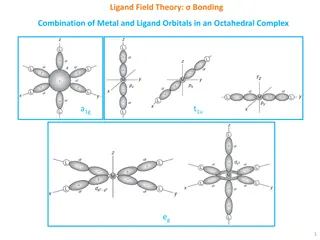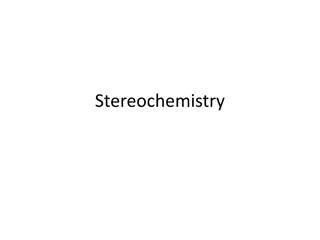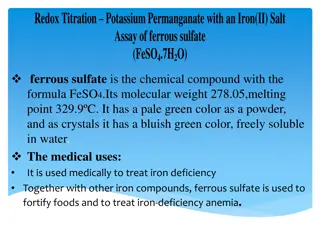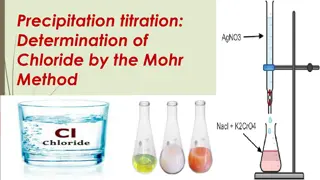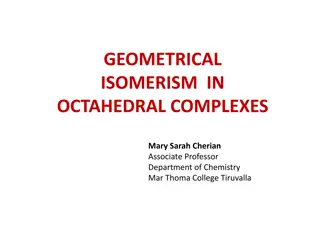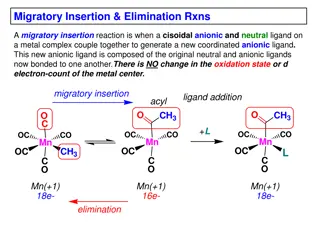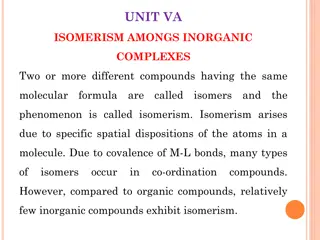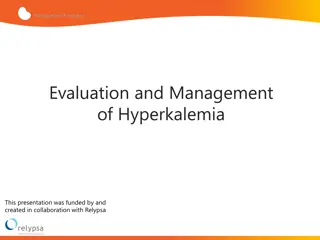Understanding Geometrical Isomers in Potassium Chromate Complexes
Explore the preparation methods, crystal shapes, and properties of cis and trans isomers of potassium chromate complexes. Learn about the use of oxalic acid and potassium dichromate, compare the two isomers, and understand the oxidation and reduction reactions involved.
Download Presentation

Please find below an Image/Link to download the presentation.
The content on the website is provided AS IS for your information and personal use only. It may not be sold, licensed, or shared on other websites without obtaining consent from the author. Download presentation by click this link. If you encounter any issues during the download, it is possible that the publisher has removed the file from their server.
E N D
Presentation Transcript
: (Geometrical Isomers) Potassium trans-dioxalato diaqua chromate(III) dihydrate , trans-K[Cr(C2O4)2(H2O)2].2H2O. & Potassium cis-dioxalatodiaquachromate(III) dihydrate Cis-K[Cr(C2O4)2(H2O)2].2H2O) . ) 1 (Linkage Isomers) ) 2
Preparation of Potassium cis- dioxalatodiaquachromate(III) dihydrate Cis-K[Cr(C2O4)2(H2O)2].2H2O . Preparation of Potassium trans-dioxalato diaqua chromate(III) dihydrate trans- K[Cr(C2O4)2(H2O)2].2H2O . 1) Mix (12g) of aqueous oxalic acid with (4g) of potassium dichromate, grind the mixture using ceramic mortar, and continue gridding until you get homogeneous mixture. 2) Moisten a ceramic bowl with distilled water and put the mixture powder and cover it with watch glass. 3) Add to Put the ceramic bowl on a quiet hot and wait for a small period, as a rapid and continuous reaction will start leading to form a dark and heavy liquid. 4) add to the dark liquid (20ml) of ethanol and crush contains using a metal spoon until it solidify. 5) Filter the solution to get granular crystals represents cis isomer. 6) Weight the precipitation (cis complex) and calculate the ratio. 1) Mix (12g) of aqueous oxalic acid with least quantity of hot distilled water in a backer, and dissolve (4g) of potassium dichromate in least quantity of hot distilled water in another backer. 2) Add dichromate solution to oxalic solution and cover the backer with watch glass after each addition and stir to continue the reaction, and then leave the solution to cool down for (24) hrs. 3) Filter the solution, wash the crystals with (5ml) of distilled water, and then with ethanol to get trans isomer. 4) Dry the formed precipitation , and calculate the ratio of the complex.
Reaction equation: K2Cr2O7+ 7H2C2O4.2H2O 2Cis-K[Cr(C2O4)2(H2O)2].2H2O +13H2O +6CO2 Questions: 1) What is the purpose of using oxalic acid and potassium dichromate? 2) What is the shape and color of the produced crystals? and what is the reaction type and preparation method? 3) Compare between trans-K[Cr(C2O4)2(H2O)2].2H2O and Cis-K[Cr(C2O4)2(H2O)2].2H2O.? 4) Write down the oxidation and reduction equations for both complexes.
) ( , . . !







